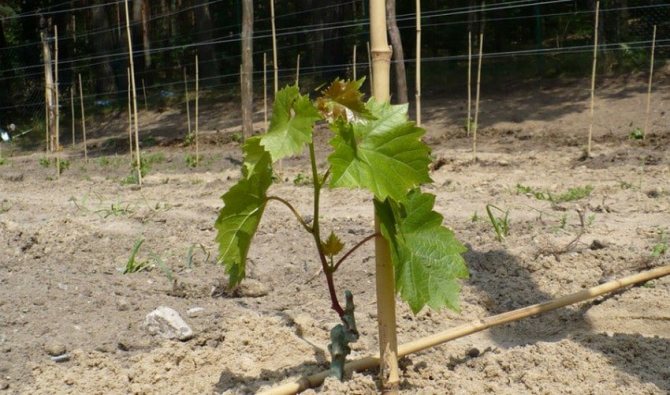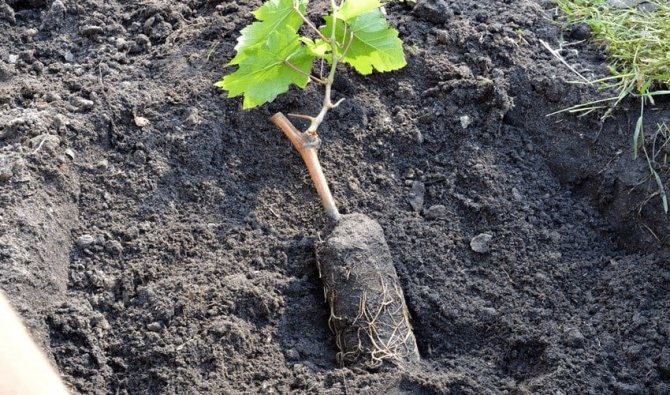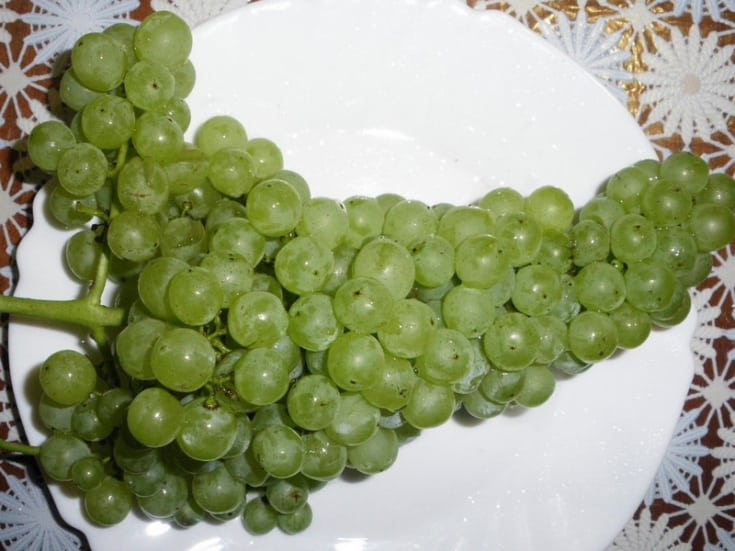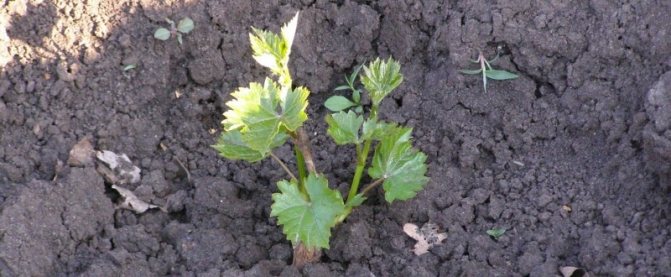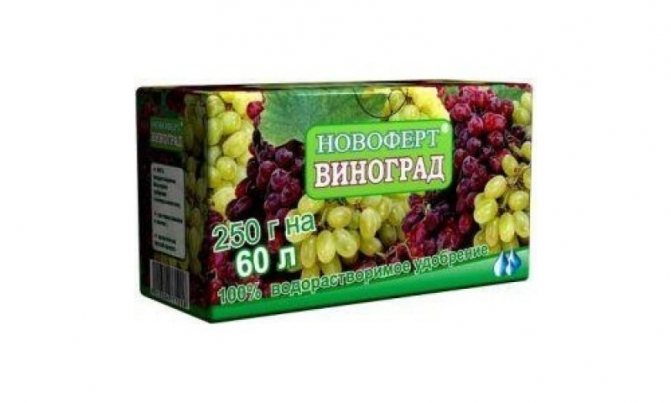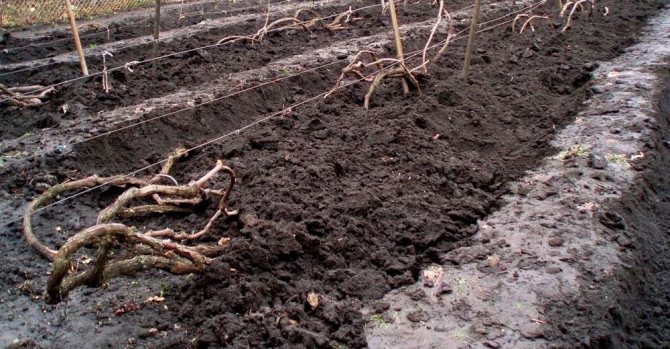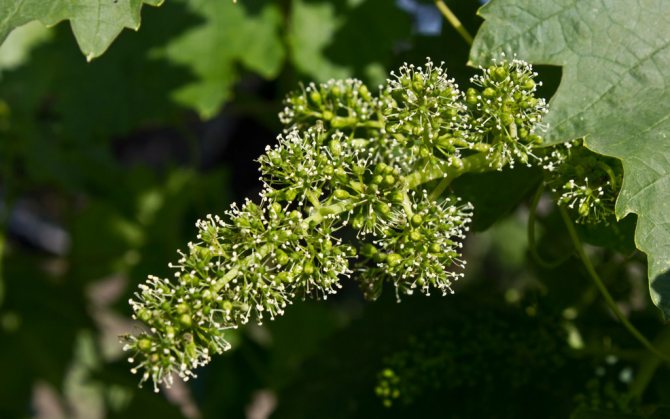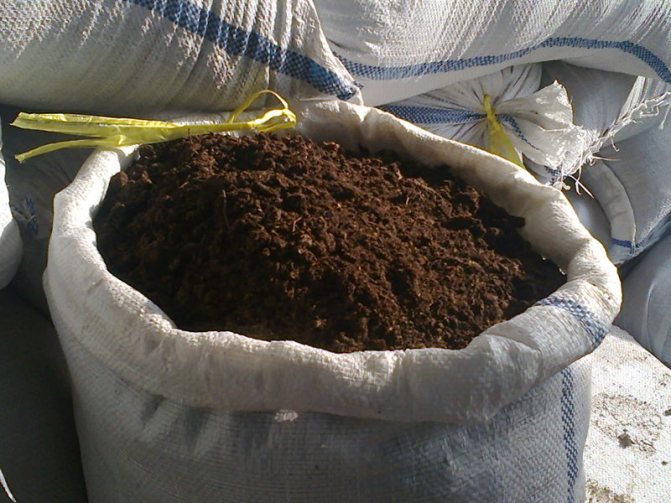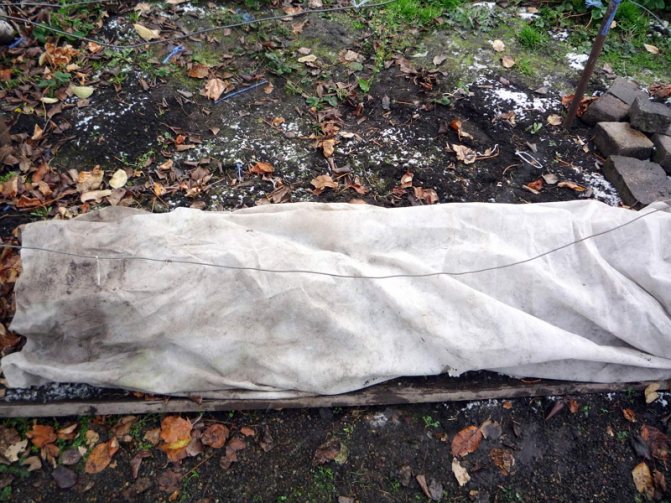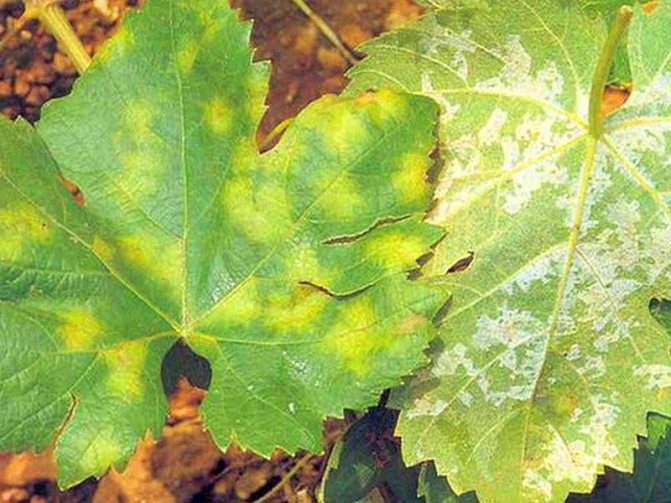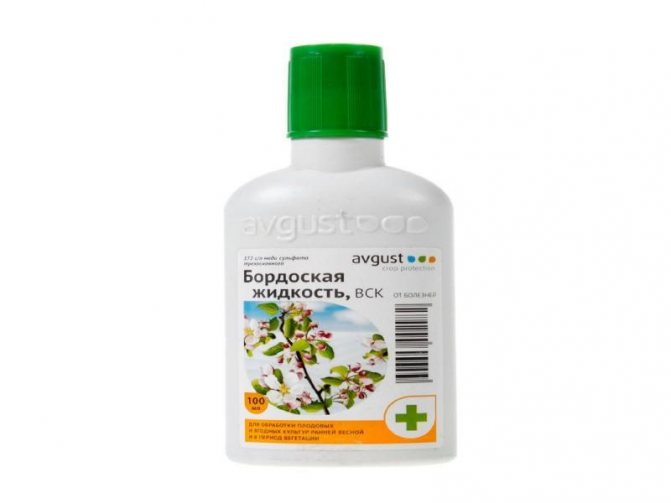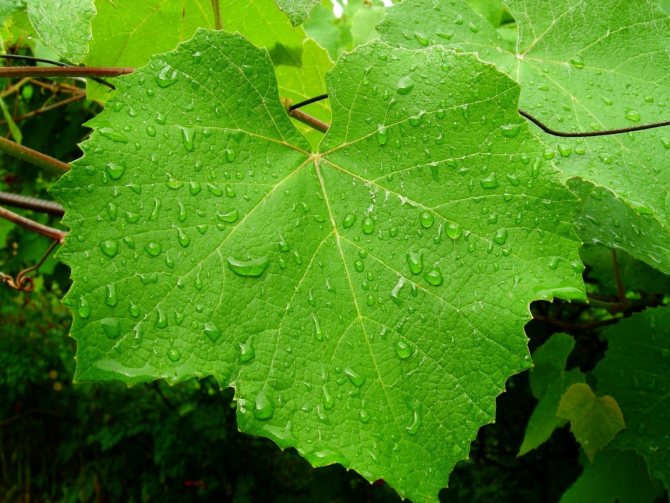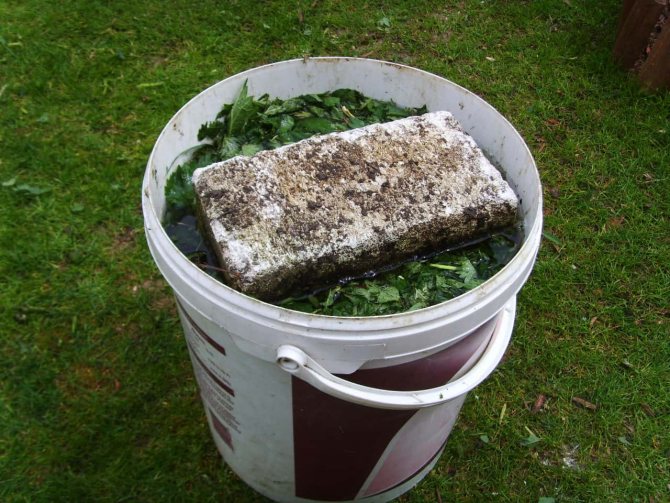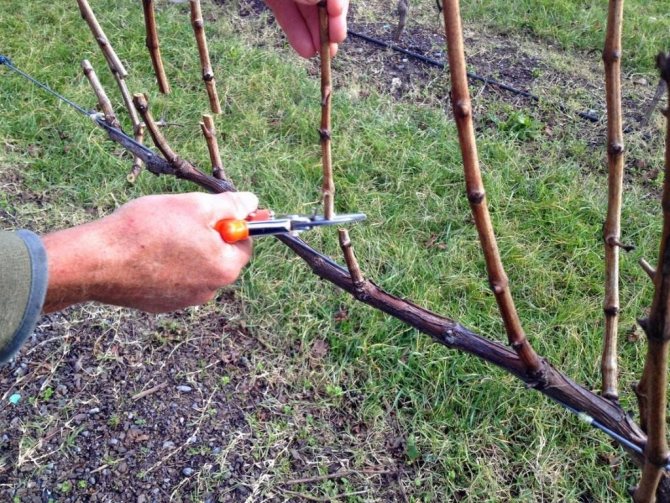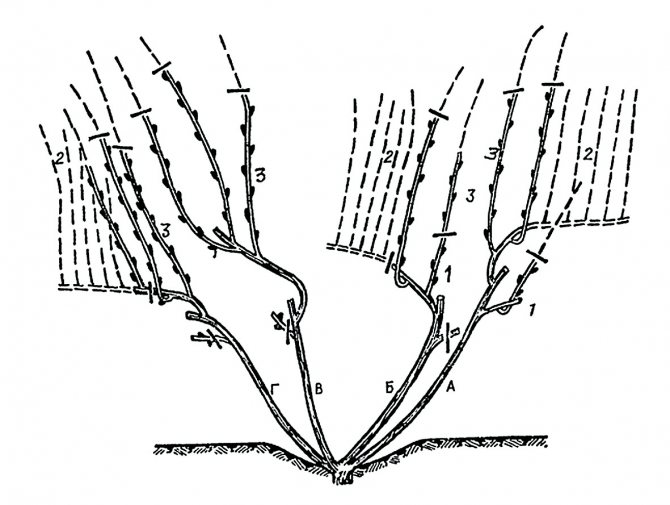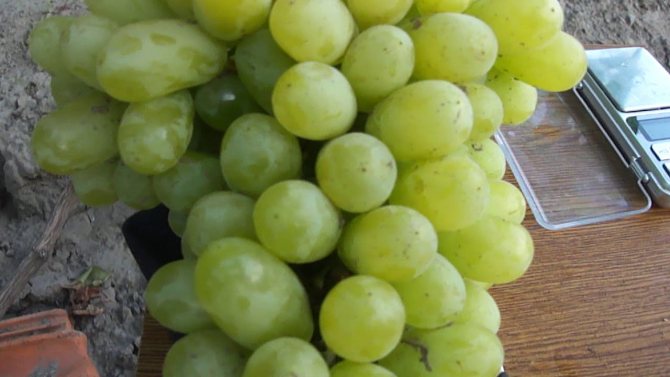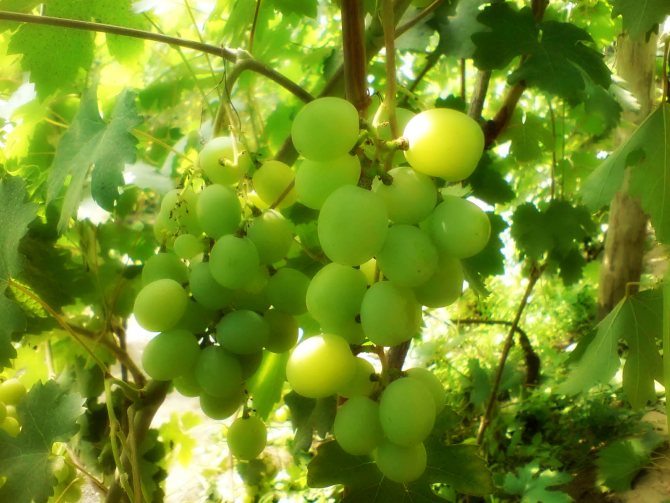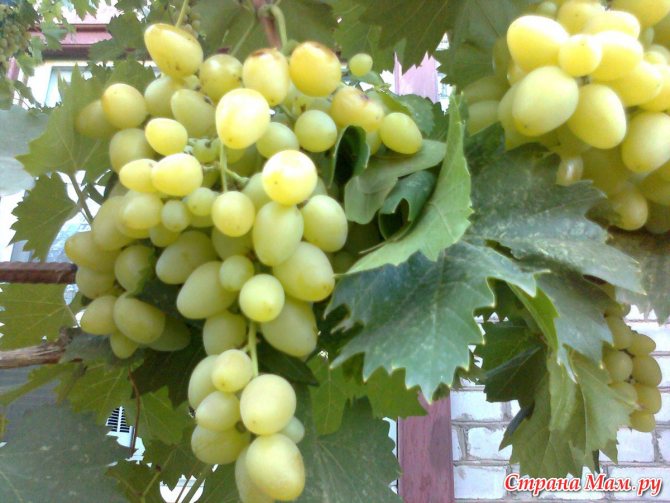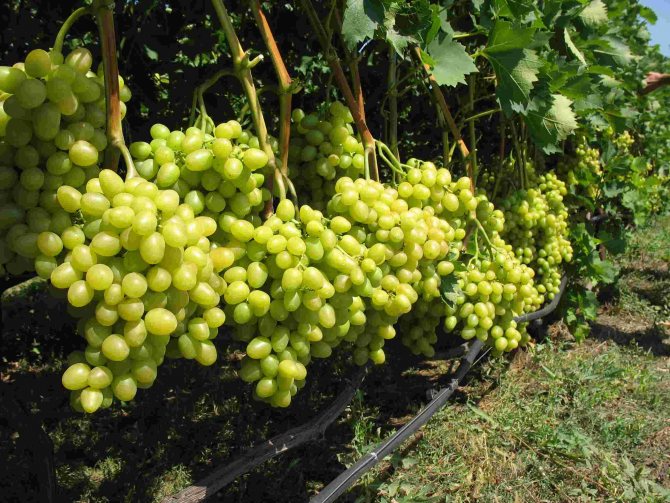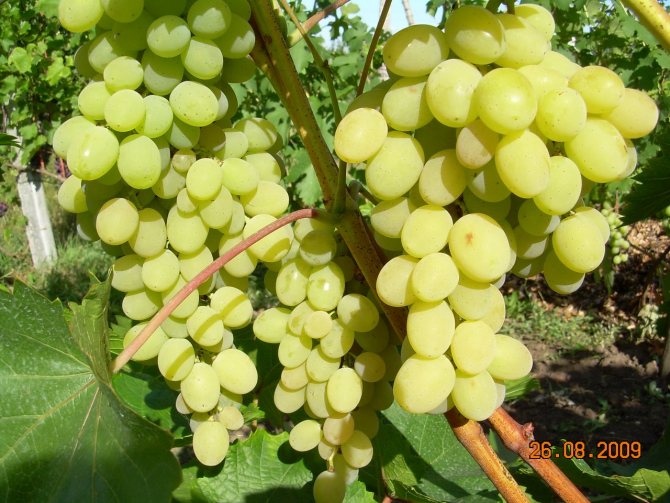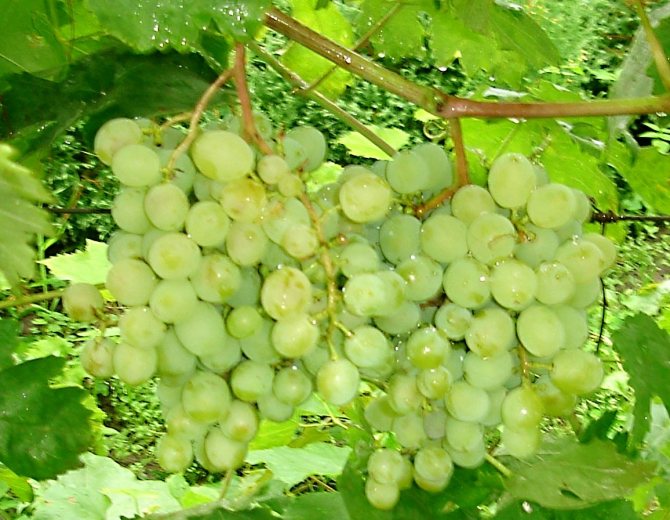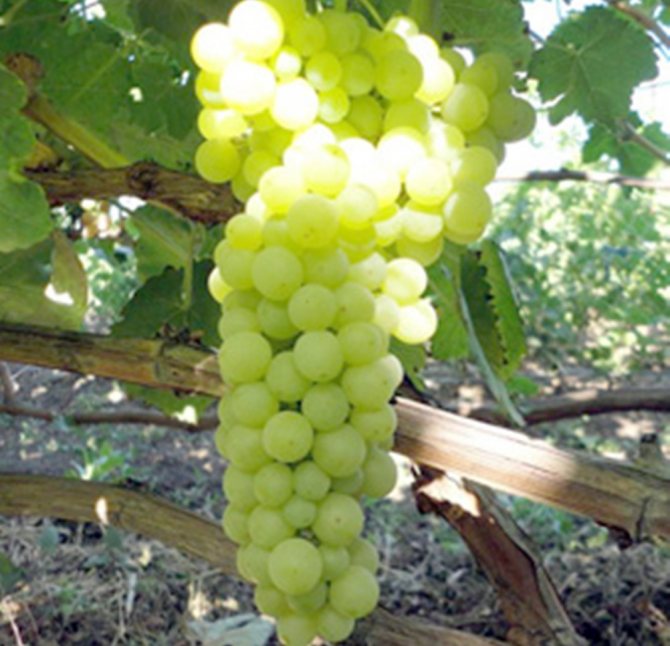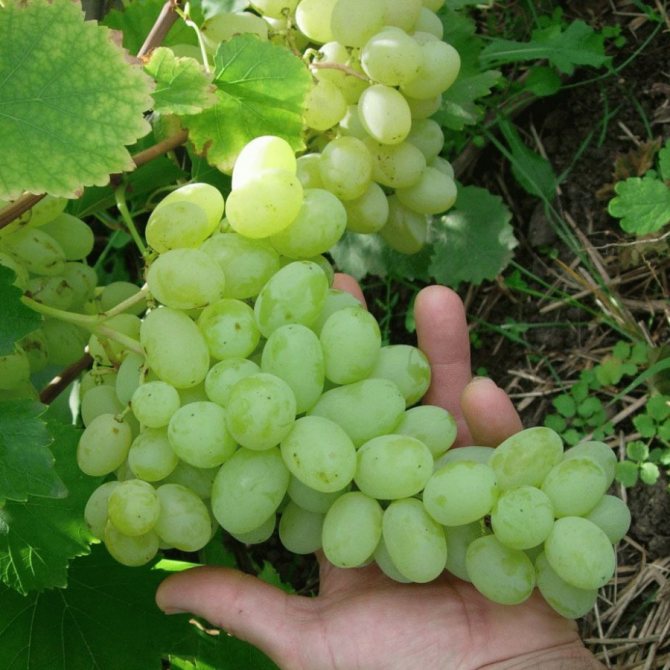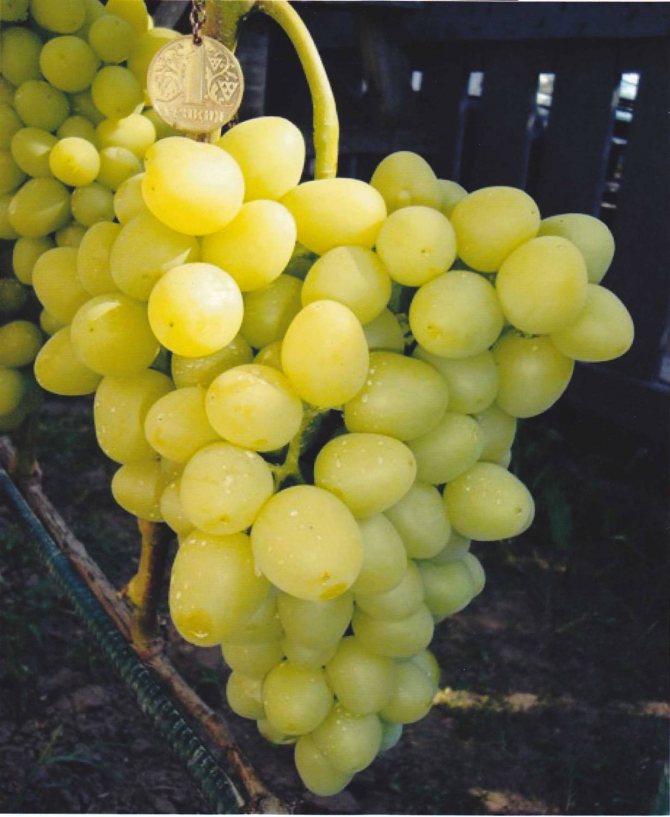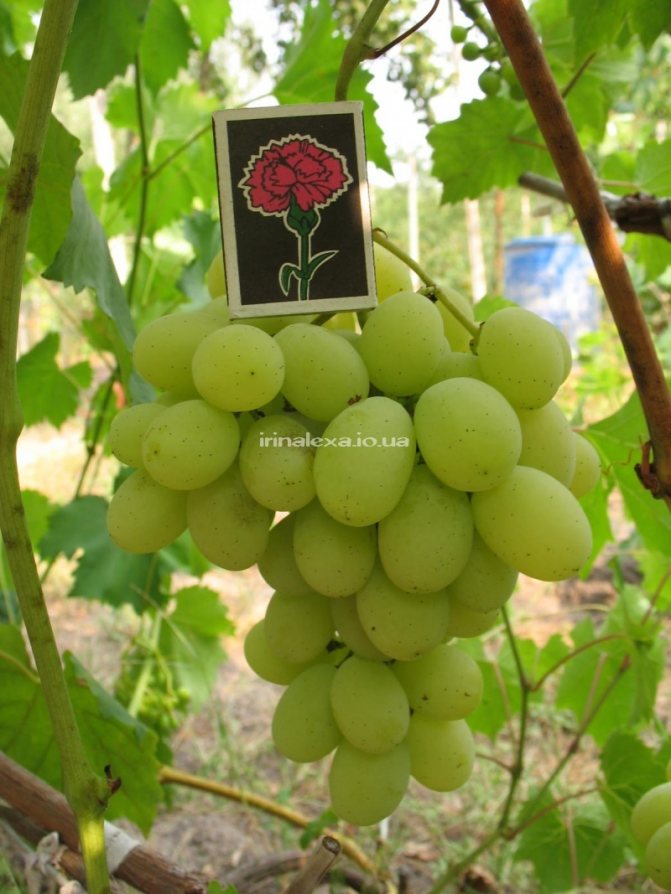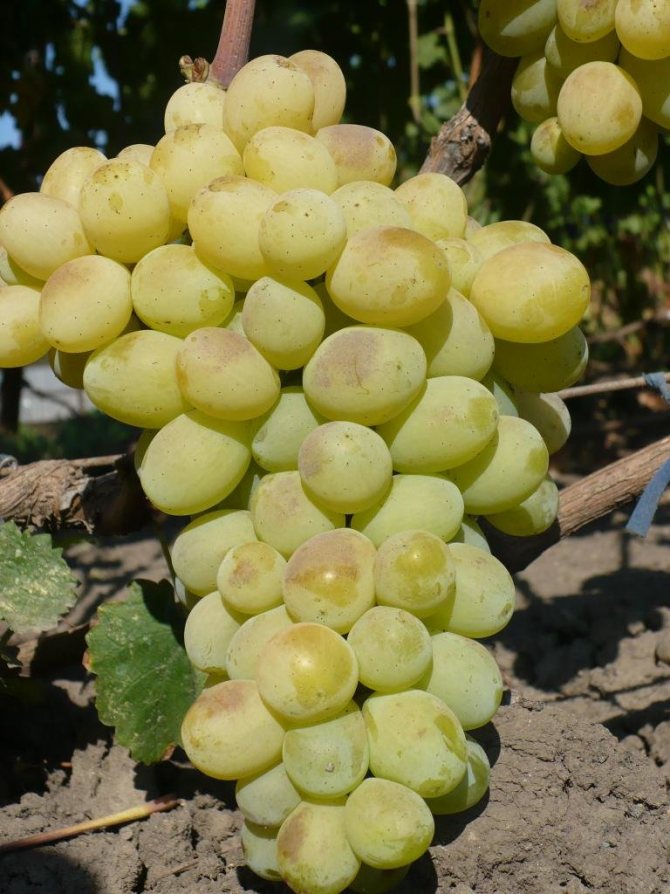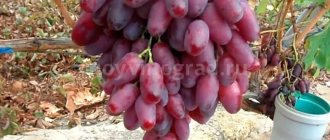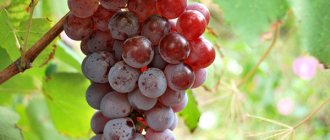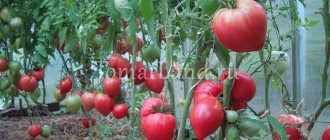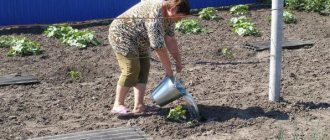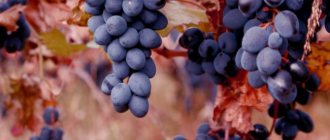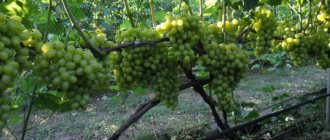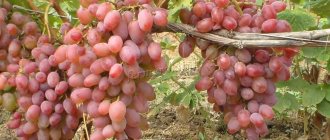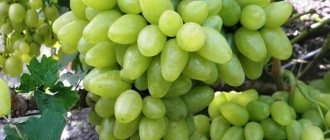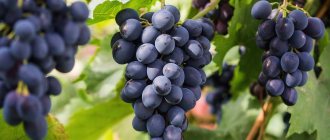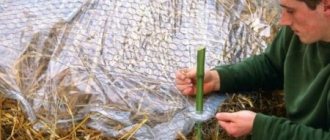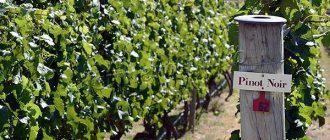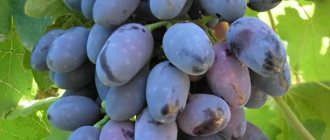Characteristics of the variety
The description of the Laura variety will interest many amateur winegrowers, which is due to the very interesting combination of parental pairs used in the breeding work. Nowadays the variety is better known as "Flora".
Biological description
The grapes of this variety are characterized by an early ripening period. From the moment the eyes open until the berries are fully ripe, 110-115 days pass. The bushes have an above average growth vigor and a female flowering type, which does not interfere with productive pollination. The vine ripens very well. Fruitful shoots - from 60 to 80%, the number of clusters - from 0.9 to 1.3 for each shoot.
The grape clusters are large: the average length is 40 centimeters and the weight is over 1 kg. When using vigorous rootstocks, it is possible to obtain clusters weighing up to 3 kg. The grape cluster has a pronounced conical shape and medium density or slight friability, which depends on pollination and vine growth.
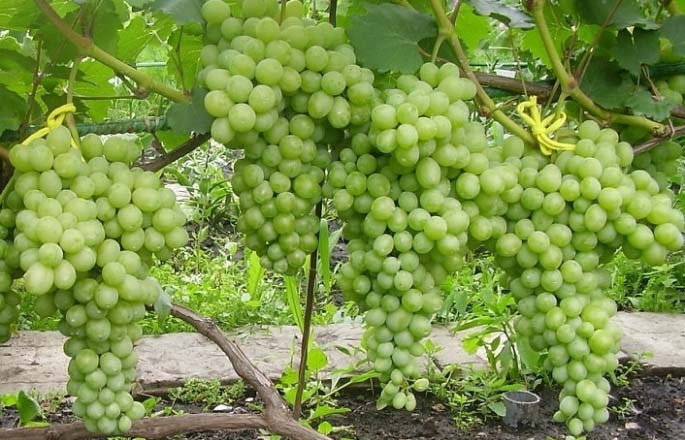
Technical specifications
The berry has a cylindrical or oval shape, weighing from 10 to 12 g. External data is very good. The main coloration is white with a light green tint and the presence of a slight white prune. The sunny side of the berry is very often characterized by a light tan.
The pulp is dense, crispy, with a pleasant berry flavor. Sugar accumulation is sufficient and may exceed 20%. The acidity values of the juice vary from 5 to 8 g / l. The berries contain large enough seeds, can persist for a long time on the bushes and are practically not prone to cracking.
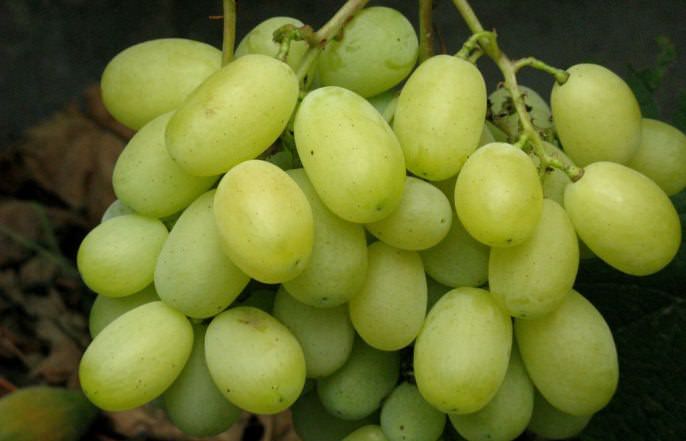

Advantages and disadvantages
The main advantages of the variety are known to most winegrowers:
- the vine is characterized by good and full ripening;
- increased resistance to mildew, which is 3 points;
- there is almost no risk of gray mold damage;
- frost resistance reaches -23 ° С;
- the transportability of the harvested crop is very good;
- high rates of pollination;
- the variety belongs to the category of large-fruited and high-yielding.
- external characteristics and consumer qualities of grapes are very high.
When growing this variety, one should take into account such a disadvantage as the susceptibility of the vine to damage by powdery mildew.
Diseases and pests
The Laura variety is not at all susceptible to the attack of gray rot, it is extremely rarely affected by mildew, since it has a high resistance against it.
The main danger is oidium, against which Laura has no immunity at all. To avoid infection, carry out regular treatments with various means.
Against powdery mildew and some other fungal diseases they use:
- Sulfur preparations. You can spray the bushes with liquid colloidal or dust with ground, powdery;
- A solution of potassium permanganate of medium concentration. It should be painted a pleasant pink;
- Mullein infusion;
- Chemicals - Topsin M, Karatan, Rubigan, Bayleton.
At the same time, prophylaxis against mildew can be carried out with the help of Bordeaux liquid, ferrous sulfate and nitrafen.
Do not forget about the prevention of such common grape diseases as chlorosis, bacteriosis, rubella, anthracnose and bacterial cancer.Detailed information on this is presented in separate articles on our website.
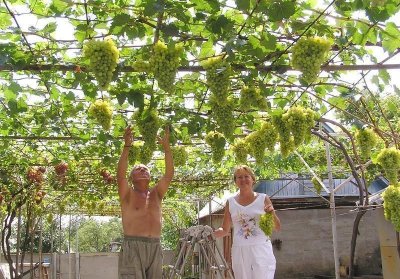

High sugar content actively attracts wasps.
Therefore, Laura needs to be protected from their attacks with nets. It takes patience to wrap each bunch.
Not far from the vineyard, traps and baits can be laid out, boric acid and organophosphates such as dichlorvos and karbofos can be used as a poisoning agent.
Among other harmful insects that prefer to feed on Laura, you can find leaf rollers, weevils, mining moths, herbivorous mites, golden beetles, mosquitoes, flea beetles, mealybugs and thrips.
Mice gnaw the vines laid for the winter. To avoid this, pieces of burnt felt or wool are laid out among the shoots. This smell is not tolerated by mice and will not be suitable for grapes.
Some bird species are not at all averse to eating delicious juicy Laura berries, so it is recommended to cover ripening clusters with nets made of polymer materials or flexible metal.
Delicious berries, a large amount of harvest, easy care, low demands on growing conditions, resistance to cold - all these qualities make Laura one of the most beloved varieties of both experienced and novice winegrowers.
Velika, Krasa Balki and Ataman can also boast of a special taste.
Photo gallery
Landing rules
Laura grapes are rather picky in terms of cultivation. However, the soil for the vineyard must be well prepared and have high fertility rates. When landing, particular attention should be paid to meeting the following requirements:
- the soil on the site for planting should not be clayey and have an increased salt content;
- in the area under the vineyard, groundwater should not rise close to the surface;
- the place should have good sunlight so that the soil warms up as quickly as possible;
- planting of prepared seedlings of this variety should be carried out in the spring with the onset of stable heat;
- the soil on the site should have time to warm up to + 10 ° C;
- the standard distance between planting pits for seedlings should be about 1-1.5 m.
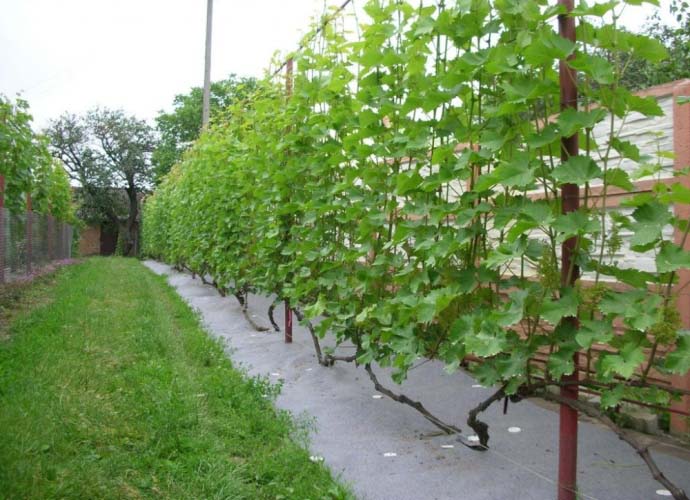

Plants require abundant watering during the first week after planting.
Planting plants in the ground and preparing for it
Laura is quite unpretentious in her care, but getting bountiful harvests is impossible, if you do not take into account the "requirements" of grapes to the quality of the soil and other growing conditions. It develops best in fertile, but rocky soil, which allows water and air to pass through well.
This culture will definitely not grow on clay and saline substrates. The close location of groundwater is also undesirable (less than 2 m to the soil surface). The selected area should be open, well warmed up by the sun. The optimal place for placing a vineyard is a slope of a gentle hill, oriented in the south-east or south-west direction. But any lowlands do not fit categorically - it is colder than on a hill, there is less sun, rain and melt water lasts longer, and damp air accumulates.
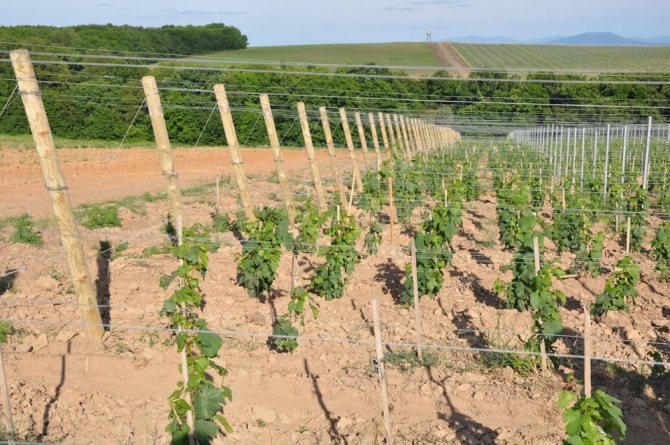

Vines love warmth and sunshine.
It is good if at some distance from the vine there is some kind of barrier that covers the plant from cold drafts, without shading it. A stone or brick wall of a house, a fence, moreover, warming up during the day, gives the accumulated heat to the vine at night.
At home, Laura can be planted both in spring and autumn. Everything is decided by the personal preferences of the gardener. But in regions with a temperate climate, the first option is much preferable. Over the summer, the plant will have time to take root in a new place, form a developed root system and accumulate enough nutrients for wintering. Landing in the fall is a big risk.Winter in these regions does not always come according to the calendar; frosts can hit quite unexpectedly. And the plant after planting in the ground takes at least two months to adapt.
At the time of planting, the soil at a depth of about 15 cm should warm up to at least 10 ° C, and the air temperature should settle at 16-18 ° C. To speed up the heating process, sprinkle the soil with sifted wood ash or tighten it with plastic wrap. Laura's vines do not grow quickly, but strongly. When planting two or more seedlings at the same time, 1.5–2 m are left between them, and 2.5–3 m between planting rows. In most regions, planting is planned for the second half of May or the first decade of June, but if the climate permits, the dates can be shifted to the end of April.
It is necessary to provide a place for the trellis. Its height is at least 2 m. It is a strong wire stretched horizontally in three rows between the supports. The bottom row is at a height of 40-50 cm, the second is 90-120 cm, the third is 160-180 cm. To prevent the vines from fraying, the grapes are tied to a support, placing a washcloth or a soft cloth. This should be done very carefully with Laura. Young shoots of this variety are extremely fragile.
How to tie up grapes on a trellis in spring:
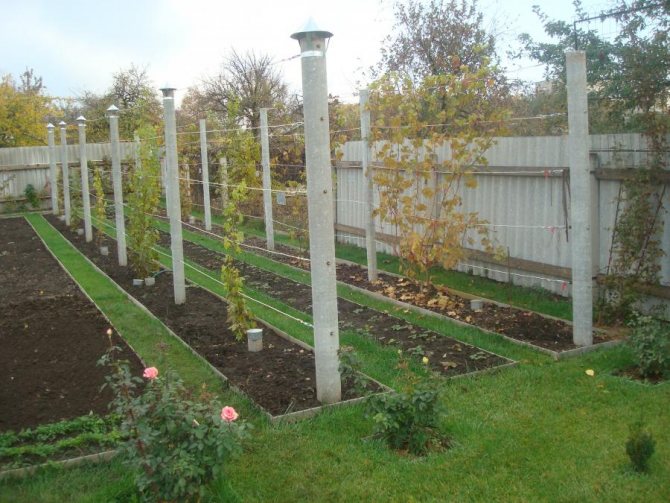

When planting grapes, they must provide a place for the trellis
The root system of any grape is powerful, so the depth of the planting pit cannot be less than 80 cm. The diameter is about 60–70 cm. The best substrate for growing a crop is black soil, but if all the necessary fertilizers are applied, Laura successfully takes root and bears fruit in almost any soil ... You just need to remember that the lighter the soil, the faster it dries out and the more it freezes, and adjust the care accordingly.
They dig a landing hole in the fall. Expanded clay, pebbles, crushed stone, small ceramic shards are poured onto the bottom in a layer not less than 8–10 cm thick. You can use other materials as drainage. Then they create a kind of "puff cake", alternating humus with fertile soil mixed with fertilizers. Be sure to add simple superphosphate (120-150 g), potassium sulfate (80-100 g) and dolomite flour (200-250 g). Mineral fertilizers can be replaced with a liter can of wood ash. There should be a total of five layers, each about 10 cm thick. The soil is well spilled with water, a piece of a hollow tube of small diameter and such length is stuck into the bottom (closer to the edge of the pit) so that it protrudes to the surface by 8-12 cm. Then the pit is closed with any waterproof material so that the soil does not erode, and left until spring ...
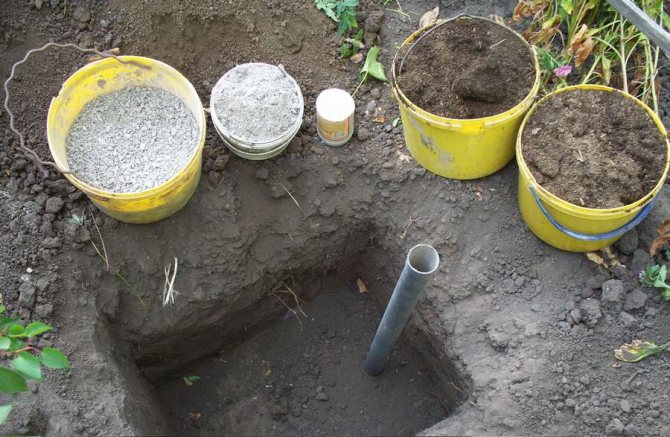

At the bottom of the planting pit for grapes, a drainage layer is required
The choice of planting material is no less important. Two-year-old grape seedlings take root best. The height of such a plant should be at least 50 cm. Several lateral shoots are required. The bark of healthy seedlings is smooth, without cracks, wrinkles and peeling, mold and rot spots, evenly colored in a reddish-brown color. The roots reach a length of 15 cm, on the cut they are white or creamy, elastic. Young shoots and leaves (if any) are colored deep green. The pale salad shade indicates that the seedlings "lived" only in the greenhouse, such specimens do not differ in frost resistance. At the base of the trunk there should be a slight "influx" - the place of inoculation. Its absence means that the seedling is grown from seed. Finding out exactly what the berries will be can only be experienced.
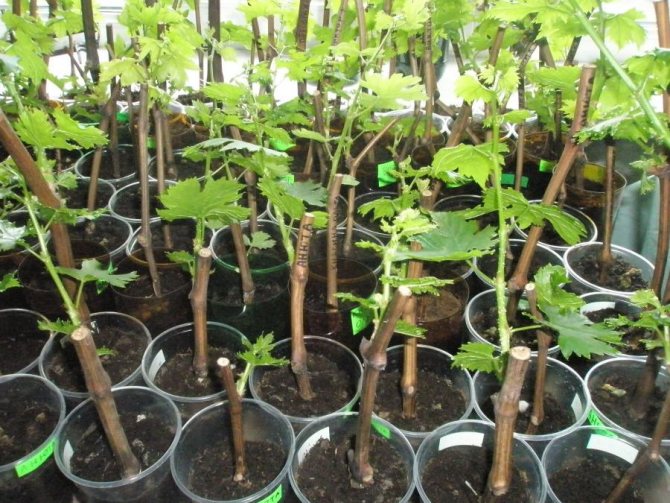

High-quality planting material is the key to a bountiful harvest in the future
Of course, purchases are made only from trusted suppliers with a good reputation. From hands or at a fair, it is highly likely to purchase low quality planting material. It is not a fact that it will be grapes, but there is nothing to say about the desired variety.It is good if the nursery where the seedlings are grown is nearby. Such plants are better adapted to the specifics of the local climate.
It is advisable to plant the purchased seedling as soon as possible. If it was purchased in the fall, it is dropped into wet peat or sand for the winter. Until the moment of disembarkation, he should not "wake up" (growth buds did not begin to swell).
Disembarkation is carried out according to the following algorithm:
- For 12-14 hours, the roots are soaked in cool water. Some gardeners advise adding a biostimulant to it, others, on the contrary, do not recommend this, claiming that this substance will have a negative effect on the formation of the vine in the future.
- After this time, the seedling is cut shortly, leaving 3-4 growth buds ("eyes"). Of the available side shoots, only two are left. The roots in the upper "knot" are cut off completely, the lower ones are shortened by a couple of centimeters. To prevent the development of fungal diseases, they are kept in a solution of any fungicide (DNOK, Baktofit, Ridomil-Gold) for a quarter of an hour.
- A little fertile soil is poured onto the bottom of the planting pit, forming a low mound. This is necessary so that the roots do not get "burns" from fertilizers. The seedling is placed on it, giving the desired position to the roots sticking up and to the sides. Plants with a closed root system are removed from the container along with an earthen clod, which is placed in a depression of a suitable diameter made in the substrate at the bottom of the planting pit.
- The pit is gradually filled with the substrate, periodically gently shaking the plant and compacting the soil so that no voids remain. The root collar, when the hole is filled up, should be 5–8 cm above the soil surface.
- Then the soil is trampled down. The grapes are watered using 20-30 liters of heated water per seedling. After about half an hour, it will be absorbed, and it will be possible to mulch the near-trunk circle with humus, peat crumbs, and freshly cut grass. Another option is to tighten it with any black covering material.
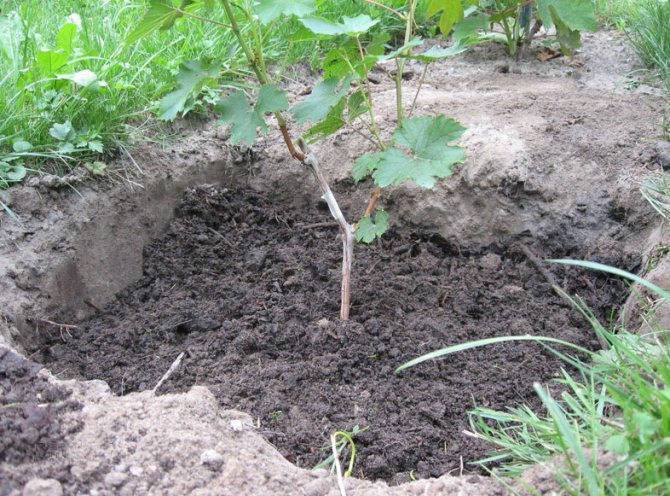

Planting grapes in the ground differs little from a similar procedure for other fruit trees and berry bushes
Video: the procedure for planting grape seedlings in the ground
Care features
Laura grapes are not too capricious and demanding in their care. Nevertheless, in order to obtain stable and high yields, as well as maintain a plant in a healthy state, the basic rules should not be neglected:
- watering of vines should be regular;
- it is recommended to carry out irrigation using special drainage holes;
- young bushes are watered at the rate of 30 liters per plant, and more mature bushes need 60 liters of liquid per plant;
- to maintain moisture and reduce the number of weeds, mulch the soil with organic fertilizers.
At the first time after planting, pruning of the grape bush is not done. In the future, the load of the bushes should be about 40-50 eyes. Laura is very stable and can produce excellent fruit with short pruning of 2-4 eyes.
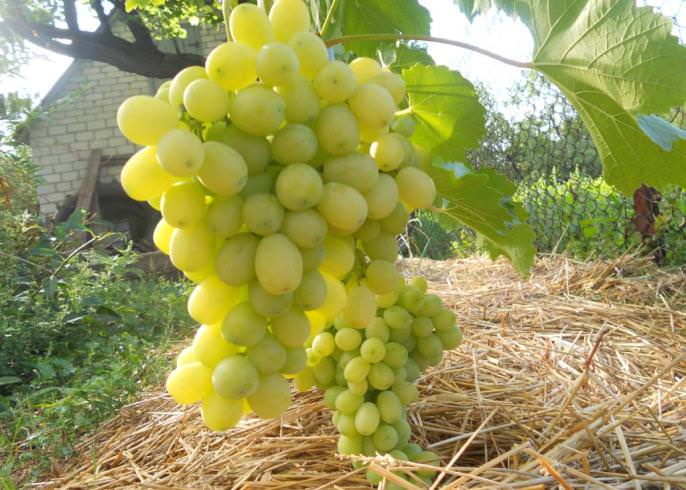

Breeding a hybrid
Laura grape variety does not differ in pretentiousness to the conditions of stay. But in order to ensure a harvest of high-quality fruits, you should choose loose soils for seedlings, located at a certain height. Not all grapes like a large amount of groundwater. If the situation requires it, equip drainage.
A prerequisite for optimal development is warm weather and light. This will allow you to build up strength for the formation of fruits. The views located along the fence or the walls of the house take root perfectly. In inclement weather, they can be additionally warmed by protecting them from drafts. The landing area is selected with minimal draft penetration.
If there are fruit trees in the neighborhood, planting grapes provides optimal light intake, while minimizing the transmission of winds. Reproduction is carried out in two ways:
In the second case, a pit is equipped for planting material, laying fertilizer in fertile soil.
In order for the culture to develop well and not infringe on the nearby bushes, a distance of at least 1.2 m is provided between them.When growing along a fence or wall of a residential building, you need to move away from them by one and a half meters. This ensures an optimal supply of air and nutrients. The seedlings are not moved into the holes immediately, but by the end of the second week.
Read also: Soil for seedlings of tomatoes and peppers: composition, soil preparation at home
During this period, the soil must be moistened. Determine the amount of water visually. There should be no significant moisture. Sprinkle the roots of the cuttings with soil, mixing with mineral dressing. Seedlings are prepared for subsequent planting, in accordance with the scheme.
Grow roots in water. For this, the process is immersed 20 cm into the substrate. After the formation of strong roots, a young bush is moved to a new place.
Gardeners reviews
Laura grapes are characterized by experienced growers as very responsive to a good level of agricultural technology, as well as to the introduction of high doses of high-quality fertilizers. The prospect of cultivating this hybrid form is confirmed by long-term cultivation in many wine-growing regions. Even the signal bunches of Laura grapes look very dignified.
Gardeners describe this variety as consistently showing excellent results and forming large and unusually tasty berries, as well as beautiful clusters. Laura is very resistant to many diseases and is one of the best varieties on most home gardens. The grapes are characterized by flexibility in terms of care, and are also optimal for cultivation in regions with fairly mild climatic and weather conditions. Even in the most unfavorable years, an excellent harvest of marketable and tasty berries is formed.
Breeding history and breeding region
Laura is the brainchild of IViV named V.E. Tairovalocated in Odessa. A compound hybrid, Husayne, Muscat de Saint Valier, Queen Tairovskaya, Hamburg Muscat (a mixture of pollen) participated in the crossing.
In the Ukrainian State Register it is listed under the name Flora.
Among the hybrids, it is worth noting such varieties as Gordey, Rumba, Valek and Timur.
How to prune grapes in autumn (video)
The Laura grape is considered to be a promising variety and occupies a leading position in the market. Winegrowers not only in our country, but also abroad successfully cultivate this variety and recommend it for cultivation in private farms and private farmsteads.

